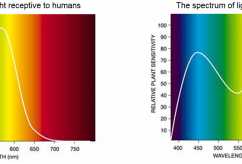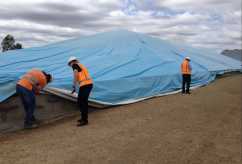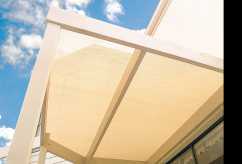Glossary of Industrial Textile Terms

In case we are using terminology you don't understand, use this handy reference guide to learn some of our technical language.
Abrasion Resistance: The measurement of how a fabric reacts with repetitive rubbing or abrasive action. Can also to be considered with sewing thread and webbing abrading against fibres in shade cloth.
Accelerated Age Testing: Laboratory tests which expose fabric to sustained levels of UV exposure and moisture, which can indicate textile performance in an accelerated manner; over normal exposure.
Acrylic Lacquer: A final coating of acrylic lacquer in gloss, satin or a matt finish which can be applied to one or both sides of a PVC which reduces soil adhesion, improves overall looks, extends UV life and slows plasticizer migration.
Air Permeability: Is the measurement of air flow through a fabric.
Anti-Wicking: An anti-wick base cloth is a chemical treatment applied to the base cloth to prevent capillary action which draws in unwanted moisture etc associated stains in the base cloth. This is most relevant of multifilament fibres such as polyester and polypropylene.
AS 4174: Australian Standard for Knitted and Woven Shade Fabrics. This Standard specifies requirements for the classification, performance and labelling of knitted and woven shade fabrics for horticultural and human protection applications.
Base Fabric/Base Cloth/Scrim: The uncoated fabric where a coating of PVC, PE, PP or other is applied to.
Biaxial Stability: The Stress/Strain behaviour of a technical textile under load in both warp and weft directions.
Bow flaw: When the weft yarns lie in an arc across the width of the fabric. The pattern in the middle of the fabric is ahead or behind the sides. Bow is defined as the greatest distance, measured parallel to the selvages.
Breaking Force or Tensile Strength: How much breaking force (measured in Newtons or in kgf) is required to break a 50mm width of fabric by pulling at each end.
Bursting Force or Ball Burst: The force required to burst through fabric used a ball bearing 1 inch / 25mm in diameter.
Bursting Pressure: The force needed to burst through fabric using a diaphragm and fluid. A specimen of fabric is clamped over a rubber diaphragm in the tester and distended by applying fluid pressure until it ruptures.
Butt Seam: A seam created when the two pieces of fabric are butted together then a strip of the same fabric is welded over the join.
Calendar or Laminate Coating: Where two preformed PVC films are heated and squeezed onto either side of a scrim or base cloth.
Coating: The outer layer applied to a fabric for waterproofing and protection of the fabric yarns.
Coating Adhesion Strength: The strength of the adhesion between a base scrim and surface coating – commonly measured as a weld peel.
Colour Fastness: The measurement of colour fade when exposed to UV radiation. Colour fastness can be measured against a Blue Wool or Grey Wool Scale.
Cover Factor: The UV radiation (350 nm) transmitted through a specimen of shade fabric.
Denier: Denier is a measure of fibre finesse or the weight of the yarn. The higher the Denier figure the heavier the yarn. 1 Denier equals 1 gram per 9,000 meters of yarn.
Dtex: Grams per 10,000m of yarn.
Elongation: The amount a fabric stretches when put under load.
Elongation at Break: The percentage a fabric will stretch at breaking point.
Extrusion: The molten product forced through a die profile.
Extrusion Coating: An extruded film which under heat and pressure is adhered to a base scrim.
Flex Crack Resistance: The ability for a fabric to withstand constant flexing on a hinge point, where the number of cracks, depth and length of cracks as well as delamination can be measured.
Flutter or Wind Flap: Excessive, uncontrolled movement, usually caused by the interaction between the structure and wind. This occurs when the fabric lacks sufficient tension or insufficiently secured. Wind flap will shorten the life span of any fabric, Woven PE in particular.
FR: Fire Retardant or Fire Resistance is where additives are added to make the fabric better at self-extinguishing when the ignition source is removed. In other words, if you hold a lighter to fabric it will burn but when you remove the lighter, the fabric will stop burning after a short period of time. FR does not mean it will not burn or melt, when exposed to high temperatures.
GSM: Stands for “grams per square metre” which is how we describe the weight of the fabric.
Heat Setting : An inferior process to Stentering. A heat treatment mainly applied to shade cloth and woven PVC mesh where the fabric is rolled over heated rollers or a heated surface or steam is applied to improve the lay flat characteristics and to minimize the fabric rolling back on itself.
High Frequency Welding or HF Welding: A style of welding machine where PVC is overlapped then a horizontal bar squeezes the PVC, electricity passes through and with heat and pressure the PVC is welded. You cannot HF weld PE or PP.
Hot Air Welding: A common way to weld PVC, PE and PP. A hot air welder blows hot air and then squeezes the two layers together between two wheels to achieve a weld or seam.
Keder: Coated PVC cord used as a “rope edge”. Rope edges provide strength and a surface to evenly distribute fabric tension forces. Used in tent structures, caravan awnings, billboards, posters and banners.
Lap Seam: Seam created when the two pieces being joined are overlapped by the width of the seam.
Light Transmission: A measure of light which passes through the fabric.
Loom: A machine used to weave base cloth.
Masterbatch: A concentrated mixture of pigments and/or additives used to blend with a base polymer during an extrusion process.
Monofilament Yarn: A monofilament Yarn is a continuous yarn made of a single round profile.
Membrane: The fabric panels used in tension structures, water containment liners, etc.
Multifilament Yarn: Multifilament yarn is made up of many smaller yarns that are typically twisted to make up one yarn. The number of individual filaments that make up a yarn can vary.
Newtons: A Newton (N) is the International System of Units (SI) derived unit of force. One newton is the force needed to accelerate one kilogram of mass at the rate of one metre per second squared in direction of the applied force.
Openness Factor (O-F): The amount of open space in the material versus the amount closed. Can be confused with Cover Factor.
Panama Weave: A Panama weave is widely used in heavy duty coated fabrics as it provides a high tear strength. This is a 2 x 2 (2 over 2) weave pattern.
PAR: Photosynthetically active radiation in the range 400 nm to 700 nm.
Patterning or Plotting: The process of defining two-dimensional pieces of fabric, which can be joined together to form a desired three-dimensional shape.
PE or Polyethylene: A thermoplastic polymer used in many types of applications including packaging, plastic bags, plastic films, plastic bottles and geomembranes. Often combinations of LDPE and HDPE in coated fabrics. Offers excellent chemical resistance and a combination of strength and flexibility. Also commonly used to manufacture fibres used in shade fabrics.
Plain Scrim: Is a popular 1 x 1 pattern (1 over 1).
Plasticizer Migration: Plasticizers make PVC soft and flexible. Plasticizers naturally migrate to the surface making the surface sticky and smelly. As this happens the PVC loses its flexibility and eventually cracks. Overall quality of raw materials and different coating finishes will slow this process down.
PP or Polypropylene: Similar to PE but generally offers better strength and flex crack resistance. Available in a range of grades from high in stiffness and strength to high in flexibility and ductility.
PU or Polyurethane: PU offers excellent resistance to solvents, fats, greases and petrol as well as very good abrasion resistance.
Pre-Stress: Placing a Tensile Fabric under Tension prior to supporting any loads beyond its own dead weight.
PVC or Polyvinyl Chloride: Also known as poly vinyl or vinyl, is the world's third-most widely produced synthetic plastic polymer, after polyethylene and polypropylene. PVC comes in two basic forms: rigid (sometimes abbreviated as RPVC) and flexible. The rigid form of PVC is commonly in construction. It can be made softer and more flexible by the addition of plasticizers, the most widely used being phthalates.
PVDF: PVDF stands for Polyvinylidene Fluoride and is a more sophisticated surface treatment applied to one or both sides of mainly structural PVC’s and is designed to reduce plasticizer migration, reduce static electricity so is less likely to attract dirt particles, greater protection of UV degradation and allows for easier cleanability.
Railroading: This refers to fabric being turned or run with the weft running vertically as opposed to horizontally.
Reinforcement: An additional layer of fabric placed in an area of high stress to protect the main fabric.
Ripstop or Tearstop: An extra or heavier yarn is added to the weave or knit pattern in both warp and weft directions which increases overall tear resistance.
Selvage: An edge produced on woven or knitted fabric during manufacture that prevents it from unravelling.
Shade Factor: The percentage of normally incident UV-visible radiation in the range 290 nm to 770 nm not transmitted by a material.
Skew: Distortion in the construction of the fabric i.e. in the yarn that constitutes the fabric. The pattern on one side of the fabric is ahead the pattern on the opposite side. Skew (bias) is defined as the distance measure parallel to and along a selvage between the point at which a filling or course yarn, stripe, or dominant line meets the other selvedge.
Solar Absorbance (As): The percentage of the amount of solar energy which is absorbed by the screen to the amount of total solar energy falling on the screen.
Solar Optical Properties: Refers to the solar transmittance, solar reflectance and solar absorbance of the screening material itself. This is not in relationship to the type of application of the screening material.
Solar Reflectance (Rs): The percentage of the amount of solar energy which is reflected or bounces off the screening material, to the total amount of solar energy falling on the screen.
Solar Transmittance (Ts): The percentage of the amount of solar energy allowed to pass through the screening material, to the total amount of solar energy falling on the screen.
Spread or Knife Coating: Liquid PVC is spread onto a woven base cloth with the profile being controlled by a doctor blade. The liquid PVC is then passed through a curing oven to set the coating.
Stentering: A heat treatment process where a knitted or woven textile is passed through an oven under controlled tension to remove inherent stress created during manufacture, within the material and stop curling.
Tape Welder: A tape welder is similar to a hot air welder but also uses 40mm wide tape to cover the butt joint and is usually made from the same type of fabric being welded.
Tape Yarn: A tape yarn has a rectangular profile – similar to a ribbon.
Tearing Resistance or Tongue Tear or Wing Rip: A rectangle specimen of fabric in which a tongue has been cut is mounted in the jaws of a tensile tester and the force required to propagate tearing is measured. Usually expressed in Newtons, Kg or lbs. force.
Tearstop or Ripstop: An extra or heavier yarn is added to the weave or knit pattern in both warp and weft directions which increases overall tear resistance
Tensile Strength or Breaking Force or Breaking Load: How much breaking force (measured in Newtons or kgf) is required to break a 50mm width of fabric by pulling at each end.
Turnbuckle: Threaded device used with cables or rods to allow adjustment for shade sails.
Ultraviolet (UV) Degradation: The deterioration of a fabric under long-term exposure to sunlight.
UPF: Ultraviolet Protection Factor. This a recognised standard/term for clothing – not as relevant for shade fabrics.
UV Block: A measure of the ability of a fabric to block ultraviolet radiation
UVR: UVR stands for Ultra Violet Radiation in the range of 290 to 400 nanometres (nm).
UV Stabilised: UV Stabilisers are added to fabrics to extend the lifespan of the material.
Visual Transmittance (Tv): The percentage of excess light passing through the screening material.
Warp: The threads or tapes occur in the length of a fabric also known as roll length direction or machine direction (MD).
Warp Knitting: Warp knitting is a family of knitting methods in which the yarn zigzags along the length of the fabric, i.e., following adjacent columns ("warp") of knitting, rather than a single row ("weft"). For comparison, knitting across the width of the fabric is called weft knitting.
Water Penetration or Hydrostatic Head: The ability for a fabric to resist water passing through it.
Wear Resistance: How a fabric reacts to rubbing, flexing, stretching, twisting, chemical exposure, wind, sunlight, weather, heat etc.
Weaving: The process of making a fabric from yarns passing alternately over and under each other.
Wedge Welder: A wedge welder uses heat and pressure to weld, similar to hot air welding but rather than using hot air to heat up fabric, a metal wedge is heated instead.
Weft: The threads or tapes that occur across the fabric. Also referred to as cross direction (CD).
Wicking: The movement of liquid by capillary action along and through the yarns of the base fabric – most relevant in multifilament fibres.
Wind Flap: Excessive, uncontrolled movement, usually caused by the interaction between the structure and wind. This occurs when the fabric lacks sufficient pre-stress. Wind Flap will shorten the life span of any fabric, Woven PE in particular.
Wing Rip: A rectangle specimen of fabric in which a tongue has been cut is mounted in the jaws of a tensile tester and the force required to propagate tearing is measured. Usually expressed in Newtons, Kg or lbs. force.
Wrinkles: Valleys or ridges on the normally smooth surface of a fabric structure which occur due to extreme stress differences in warp and weft directions.
Yarn Strength: Also called Tenacity, to determine the breaking load of single yarns, usually measured in newtons.



